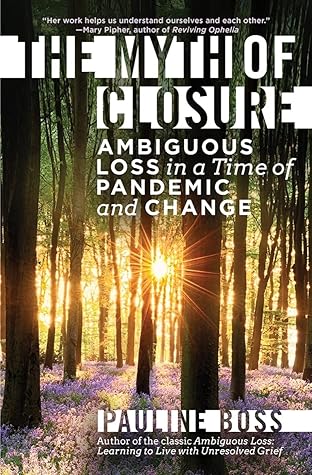More on this book
Kindle Notes & Highlights
by
Pauline Boss
Read between
April 5 - April 5, 2025
If we have loved, we will want to remember. We can do this even while moving forward in a new way.
My point is this: Continuing to use the term “closure” perpetuates the myth that losses and grief have a prescribed time for ending—or never starting—and that it’s emotionally healthier to close the door on suffering than to face it and learn to live with it.
Our task now, after a time of so much suffering, is to acknowledge our losses, name them, find meaning in them, and let go of the quest for closure.
“It’s a gift to exist, and with existence comes suffering. There’s no escaping that. … I don’t want it to have happened. I want it to not have happened, but if you are grateful for your life—which I think is a positive thing to do, not everybody is, and I’m not always, but it’s the most positive thing to do—then you have to be grateful for all of it. You can’t pick and choose what you’re grateful for.”
When ambiguous losses can’t be prevented, it is resilience, not closure, that provides us with new hope and the strength to live life in a new way.
Ambiguous loss is neither a disorder nor a syndrome, but simply a framework to help us understand the complexity and nuances of loss and how to live with it. My focus is on building resilience to live with and thrive despite a loss that can’t be clarified. Here, resilience means increasing your tolerance for ambiguity.
What helps? Letting go of the idea of closure and instead, finding meaning in our losses; thinking both/and about the positive and negative; increasing our tolerance for ambiguity; and finally, risking change by doing something different.
Ambiguous loss is a loss that remains unclear and without official verification or immediate resolution, which may never be achieved. The people we love can be physically gone but kept psychologically present—or the opposite, physically present but psychologically gone. We feel our grief, but because no death has occurred or been verified, it is often criticized as premature. Ambiguous losses then lead to a disenfranchised grief because others do not see the loss as credible and worthy of grief.
Loss of routines
Loss of being able to say goodbye to friends as schools and colleges closed abruptly
Loss of ability to attend large events—concerts, sports, lectures, reunions, and so on
Loss of trust in leaders and authorities
Feeling stuck, worthless, overwhelmed, and without hope is dangerous to your health. If such losses make you feel helpless, hopeless, or self-loathing, seek professional therapy. Doing so can save your life.
Today, I add “ghosting” to this list of more common physical ambiguous losses, meaning that someone suddenly cuts you off, vanishing from your life with no further communication or contact. Intentionally causing such an ambiguous loss is a cruel way to end a relationship.
Without a clear goodbye, they are more likely to keep hoping the lost person will return and thus may not get on with their lives in a new way.
Personal ambiguous loss happens when we lose something that affects our relationship to ourselves—no longer being as we used to be or who we were, physically and psychologically.
Losses never acknowledged remain ambiguous and unresolved, so the trauma is passed down across the generations and can erupt years later.
The ambiguous loss approach requires a new way of thinking that is more useful in times of uncertainty—like now.
The assumption is that you’ll be “over it,” done with your sorrow once you have closure. Not true.
“People wanted to call me a ‘widow’ right after he disappeared. … They would say, ‘Oh, Donna, just call yourself a widow. It will make your life easier and no one will know the difference …’”, except, she said, she would know the difference. It is not unusual for others to want closure more than the person experiencing the loss.
They take a risk to change and do not wait for things to go back to the way they were.
xviResearch shows that we do better to live with grief than to deny it or close the door on it. Boss, P., & Carnes, D. (2012). The myth of closure. Family Process, 51(4), 456–469. https://doi.org/10.1111/famp.12005


